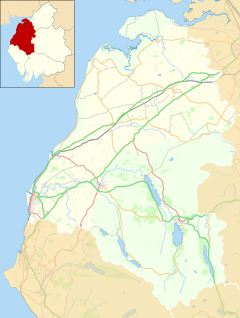
Carlisle is a cathedral city and unparished area in the ceremonial county of Cumbria in England. It is the administrative centre of Cumberland Council which covers an area similar to the historic county of Cumberland.

Maryport is a town and civil parish in Cumbria, England.

Ravenglass is a coastal village in Cumberland, Cumbria, England. It is between Barrow-in-Furness and Whitehaven. Historically in Cumberland, it is the only coastal village in the Lake District National Park. It is located at the estuary of three rivers: the Esk, Mite and Irt.
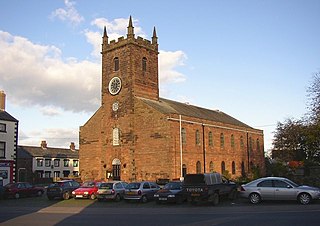
Wigton is a market town in Cumberland, Cumbria, England. It lies just outside the Lake District. Wigton is at the centre of the Solway Plain, between the Caldbeck Fells and the Solway coast. It is served by Wigton railway station on the Cumbrian Coast Line, and the A596 road to Workington. The town of Silloth-on-Solway lies 12 miles (19 km) to the west, beyond Abbeytown.

Seaton is a large village and civil parish in Cumbria, England. Historically part of Cumberland, near the Lake District National Park in England. It is home to around 5,000 people and is one of the largest villages in England. The population of the parish was measured in the 2011 Census as 5,022. Historically a part of Cumberland, it is situated on the north side of the River Derwent, across from the town of Workington, and close to the smaller village of Camerton. Seaton forms part of the Borough of Allerdale.

Allonby is a village on the coast of Cumberland in Cumbria, England. The village is on the B5300 road 5 miles (8.0 km) north of Maryport and 8 miles (13 km) south of Silloth. The village of Mawbray is 3 miles (4.8 km) to the north, and 3.5 miles (5.6 km) to the east is the village of Westnewton. The county town of Carlisle is located 26 miles (42 km) to the north east. Other nearby settlements include Crosscanonby, Edderside, Hayton, and Salta.

Hadrian's Wall Path is a long-distance footpath in the north of England, which became the 15th National Trail in 2003. It runs for 84 miles (135 km), from Wallsend on the east coast of England to Bowness-on-Solway on the west coast. For most of its length it is close to the remains of Hadrian's Wall, the defensive wall built by the Romans on the northern border of their empire. This is now recognised as part of the "Frontiers of the Roman Empire" World Heritage Site.

Beaumont is a village and civil parish in the City of Carlisle district of Cumbria, England. The village lies four miles north-west of Carlisle on the banks of the River Eden.

Bromfield is a village and civil parish in Cumbria, in the north of England.

Burgh by Sands is a village and civil parish in the Cumberland unitary authority area of Cumbria, England, situated near the Solway Firth. The parish includes the village of Burgh by Sands along with Longburgh, Dykesfield, Boustead Hill, Moorhouse and Thurstonfield. It is notable as the site of the first recorded North African (Moorish) military unit in Roman Britain, garrisoning the frontier fort of Aballava on Hadrian's Wall in the 3rd century AD. It is also where Edward I of England died in 1307.

Anthorn is a village in Cumbria, England. Historically in Cumberland, it is situated on the south side of the Solway Firth, on the Wampool estuary, about 13 miles (21 km) west of Carlisle. It is the location of the Anthorn radio station, broadcasting specialised low frequency signals for timekeeping and navigation.

Crosscanonby is a village and civil parish in Cumbria, England, historically part of Cumberland, near the Lake District National Park in England. It is situated within the Solway Coast, designated an Area of Outstanding Natural Beauty.
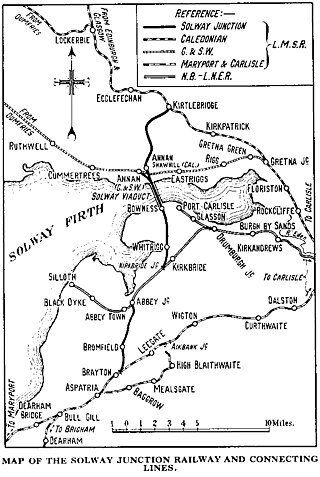
The Solway Junction Railway was built by an independent railway company to shorten the route from ironstone mines in Cumberland to ironworks in Lanarkshire and Ayrshire.
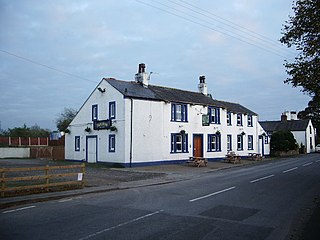
Kirkbride is a village and civil parish in Cumbria, England. The civil parish population at the 2011 census was 489.
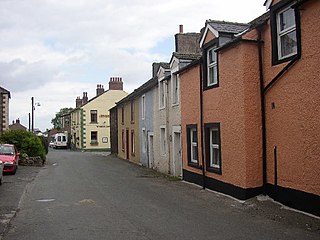
Maia, or Mais, in Cumbria, England was a Roman fort on Hadrian's Wall, and was the last fort at the western end of the Wall, overlooking the Solway Firth.

Mawbray is a village in the civil parish of Holme St Cuthbert in Cumbria, England. Historically part of Cumberland. It is located on the Solway Plain, 5.2 miles (8.4 km) south west of Silloth, 7.9 miles (12.7 km) north of Maryport, and 25 miles (40 km) west of Carlisle. The B5300, known locally as the "coast road" runs to the west of the village.

Drumburgh is a small settlement in Cumbria, England. It is 13 kilometres (8 mi) northwest of the city of Carlisle and is on the course of Hadrian's Wall, near to Burgh by Sands. The village is sited on a gentle hill with a good view in all directions over the surrounding lowlands.

Crosby Villa is a hamlet in the civil parish of Crosscanonby in Cumbria, United Kingdom. It is located on the A596 road, 3.75 miles (6.04 km) north-east of Maryport and 3.75 miles (6.04 km) south-west of Aspatria. The village of Crosby is 1.5 miles (2.4 km) to the south-west, and the hamlet of Oughterside is 2.25 miles (3.62 km) to the north-east. Cumbria's county town, Carlisle, is 24 miles (39 km) to the north-east.

Pelutho is a hamlet in the civil parish of Holme St. Cuthbert in Cumbria, historically in Cumberland, England.

Roman Cumbria was an area that lay on the north-west frontier of Roman Britain, and, indeed, of the Roman Empire itself.. Interest in the Roman occupation of the region lies in this frontier aspect: why did the Romans choose to occupy the north-west of England; why build a solid barrier in the north of the region ; why was the region so heavily militarised; to what extent were the native inhabitants "Romanised" compared to their compatriots in southern England?

